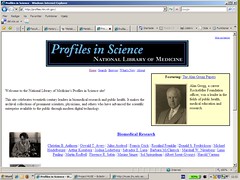 A profile is (says OED) “a short biographical sketch or character study, esp. of a public figure.” But the National Library of Medicine’s Profiles in Science site is more than a series of profiles—it’s also a potentially useful and searchable online collection of documents and iconographic material relating to “several prominent twentieth-century American biomedical scientists.”
A profile is (says OED) “a short biographical sketch or character study, esp. of a public figure.” But the National Library of Medicine’s Profiles in Science site is more than a series of profiles—it’s also a potentially useful and searchable online collection of documents and iconographic material relating to “several prominent twentieth-century American biomedical scientists.”
Unfortunately, the site isn’t easy to find through NLM’s main site. It takes some navigational and operative mouse skills to discover it. Better use a search engine. The fact that it comes up first among around 70,000 hits (today) on Google — right before Wes Kim’s celebrated short video about the fictive time-lapse photographer Dr. Albert Chung — is a good measure of its popularity and a rare example of how a history of science site can triumph over YouTube.
Profiles in Science first launched in 1998 and now contains short biographical narratives and digitized documents from nineteen biomedical scientists plus a handful of important U.S. medical doctors and health officials. Parts of the online collection are physically available for inspection at the NLM; in other cases, the repositories are placed elsewhere (e.g., the Linus Pauling papers are in the archives of the Oregon State University Libraries.
There are some good reasons for the site’s popularity. Donald S. Frederickson or Martin Rodbell may not be that well known to the general public or historians of science, but Barbara McClintock and Linus Pauling of course are, and Joshua Lederberg and Marshall Nirenberg are still household names among biomedical scientists.
Furthermore, once you have found it, the site is reasonably easy to navigate and search. It is also regularly updated. Since last summer, five new scientist profiles have been added. Each person’s profile contains a short biography and a sometimes fairly detailed description of his or her professional work. This material — competently written by a group of NLM staff members, and as far as I can judge, authoritative and trustworthy — is definitely the best part of the site. To this should be added the digitized documents (PDF files of published papers, manuscripts, diaries, letters, photographs, audiotapes, video clips, for example) all nicely reproduced; the visual side is particularly strong and reflects NLM’s high standards.
But there are downsides. The site’s usefulness for research is restricted. The NLM staff has selected documents for inclusion that “provide insight into both the development of modern biomedical science as well as the character and life of the individual scientists,” but the criteria for selection are not explained, and therefore the site is probably best used for educational and public learning purposes.
But even for these purposes, Profiles in Science is problematic. Seasoned internet users will find the site quite outmoded. The project’s creators claim to have used “modern digital technology,” but there are not even hyperlinks!! They would be well advised to take a tour around the Web, for example on Wikipedia, to learn some basic tricks of the trade. The academic, archival, and iconographic skills of the NLM are awe inspiring. What’s lacking on this site is a vision of how today’s and tomorrow’s technology can be used to put some Web life into the wonderful material in the collections.
(this is a reduced and revised version of my recent review of the Profiles in Science site published in Bulletin of the History of Medicine’s media reviews section, vol. 82(2), 431-32, 2008)
Profiles in Science: both updated and outmoded — a review of National Library of Medicine’s website
A profile is (says OED) “a short biographical sketch or character study, esp. of a public figure.” But the National Library of Medicine’s Profiles in Science site is more than a series of profiles—it’s also a potentially useful and searchable online collection of documents and iconographic material relating to “several prominent twentieth-century American biomedical scientists.” Unfortunately, the […]


